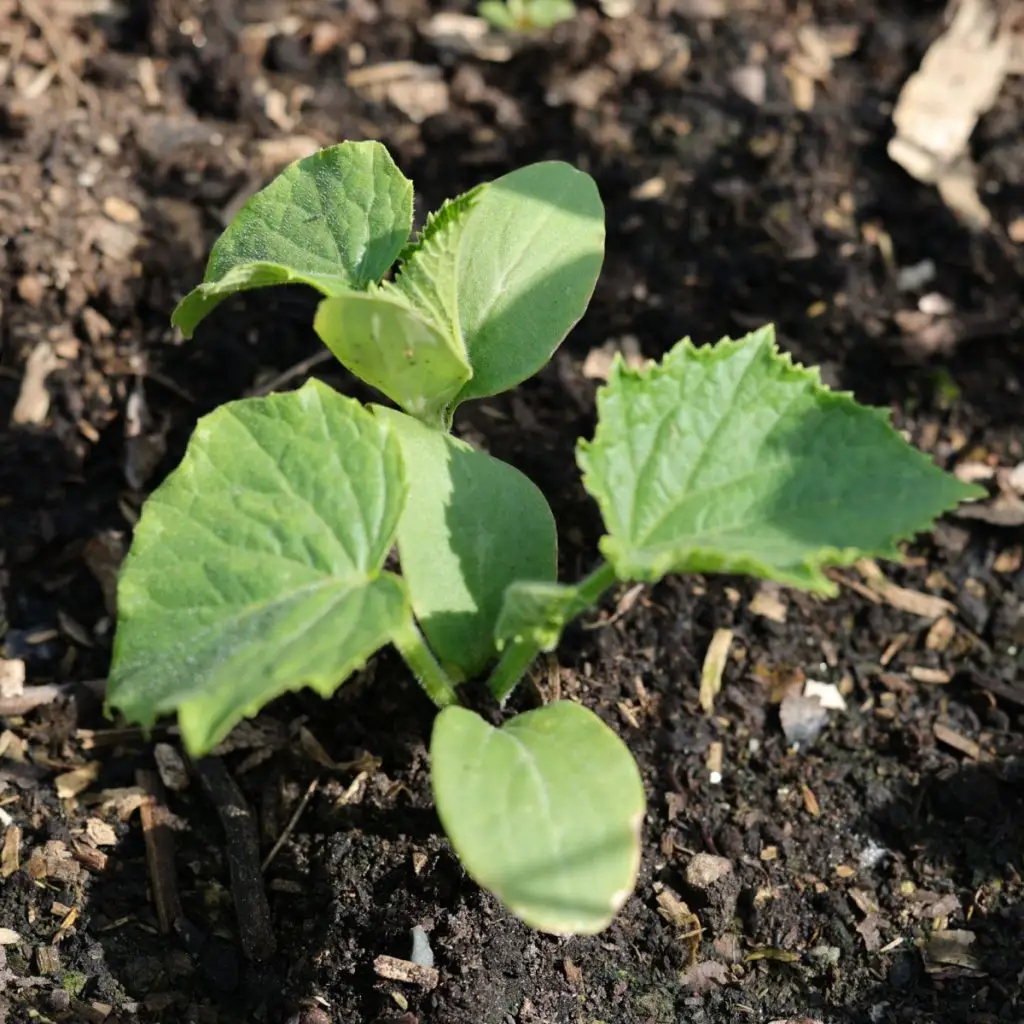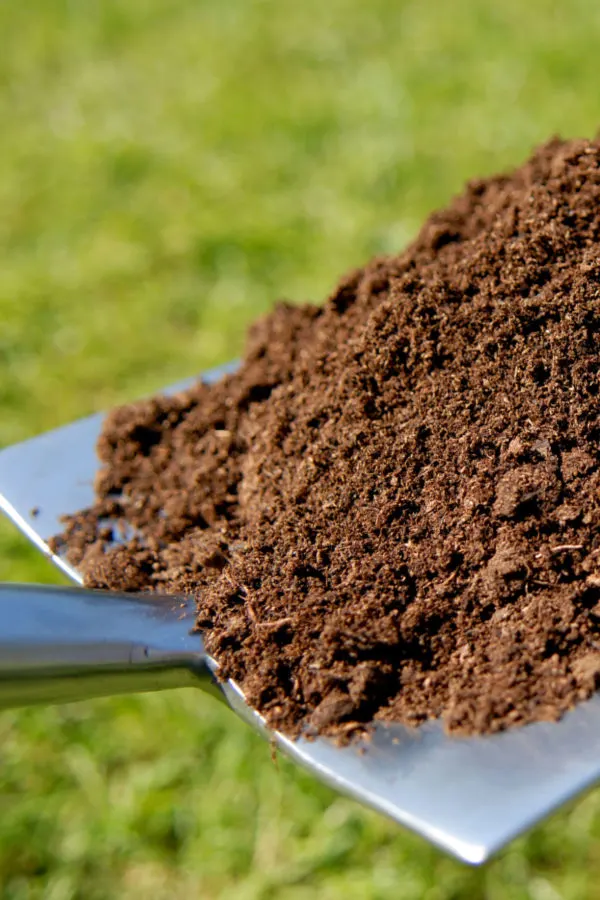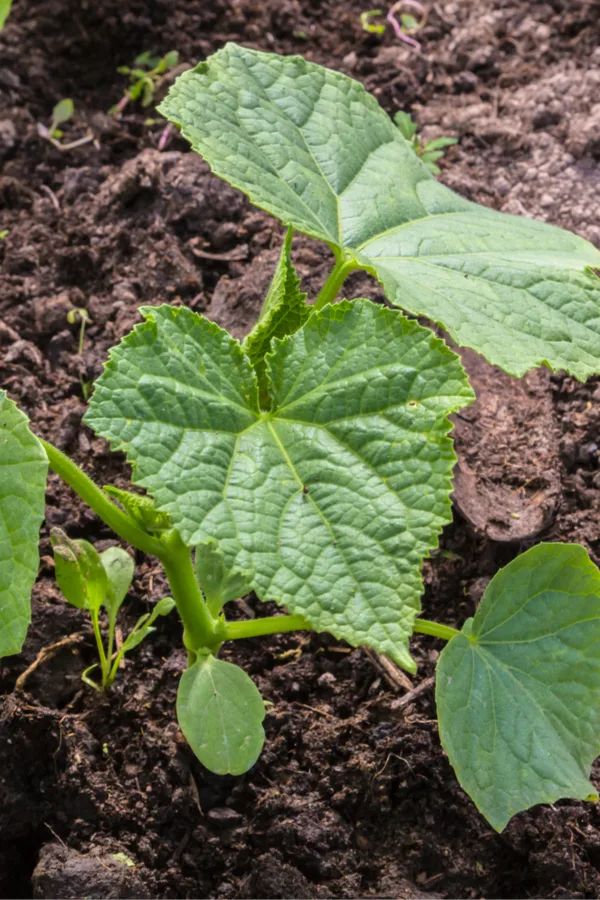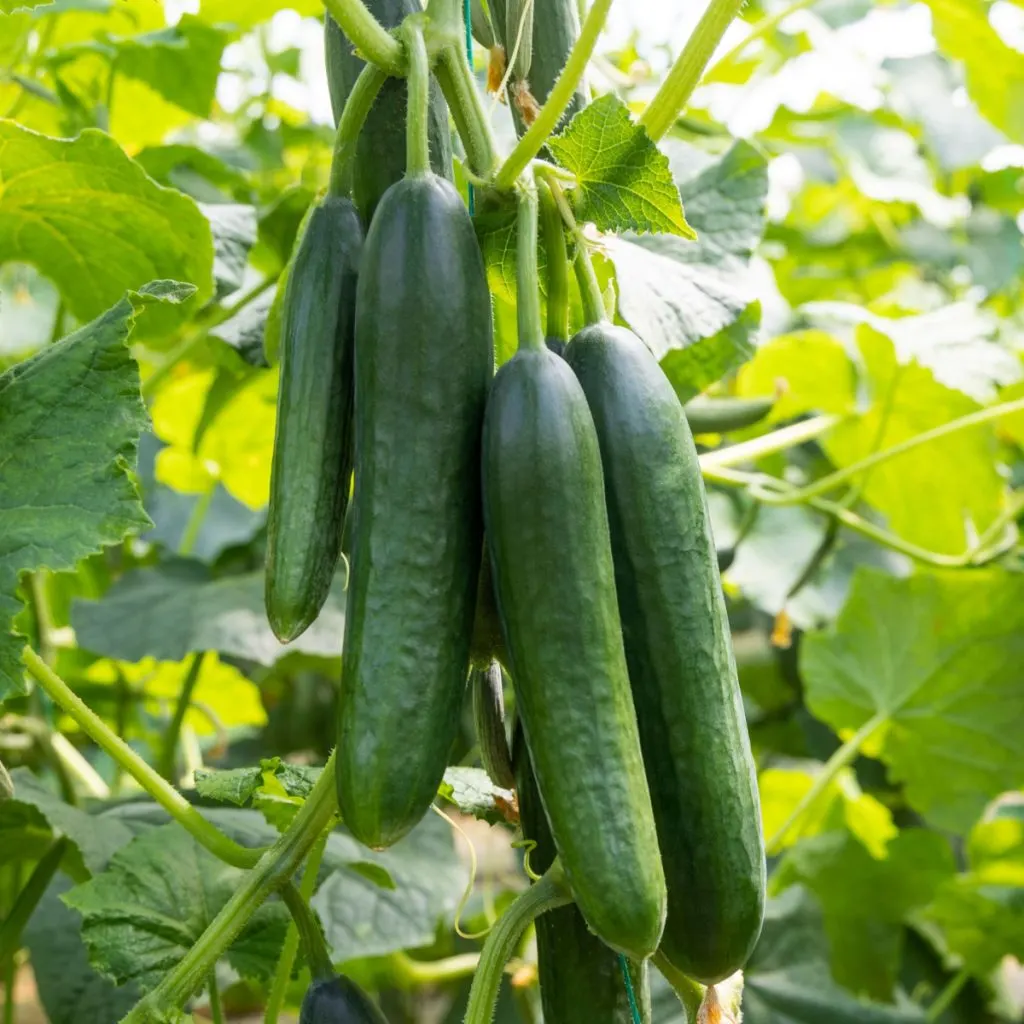Looking for a few simple tips on how to fertilize the young cucumber plants growing in your garden, raised beds or containers – and get them to take off and thrive faster than ever?
When it comes to growing healthy and productive cucumber plants, both how and when you fertilize can make a huge difference in both the longevity of the plant – and just how many cucumbers you will be able to harvest from it.
No matter where or how you grow cucumbers, they need a steady supply of nutrients to develop. Not just for later when they begin to flower and fruit, but when they first begin to grow. Without a strong system of roots or a healthy canopy of foliage, cucumbers can’t produce a strong bloom set. And without flowers, there simply can’t be cucumbers!

That is exactly why fertilizing your cucumber plants early and as they develop and mature is important. In fact, the ability to provide them with a consistent supply of energy is really the single biggest key of all to cucumber growing success.
The Best Way To Fertilize Young Cucumber Plants
There are three critical times to supply cucumber plants with power. The first is at planting time. The second is during the first six to eight weeks of their life in the soil. The third and final time is as they begin to fruit.
But even though they need energy at all three of these points, the nutrients they need differ. And by simply providing them with exactly what they need when they need it, you can all but ensure a big harvest.
With that in mind, here is a look at each fertilizing stage, and how to power your cucumber plants for maximum production and health at each point.
Fertilizing At Planting Time
Success with growing cucumbers all starts with getting them off to a great start on planting day. The best way to do that is to give them all kinds of great nutrition in their planting hole – whether your planting seeds or transplants.

When it comes to supplying energy to the planting area, nothing can beat compost. If you are planting seeds, always mix in generous amounts of compost to the soil. How much compost? A good rule of thumb is to create your planting hole or mound with a 50/50 mix of soil and compost.
Compost truly is the perfect, all-natural, fully-balanced, slow release fertilizer. Not only is it loaded with nutrients, it also contains all kinds of beneficial organisms. Most importantly, compost helps to retain moisture in the soil. Moisture that is vital to helps seeds germinate and grow quickly.
But in addition to compost, worm castings are the second secret to success. 1/4 cup of worm casting in every planting hole will do wonders to power up young cucumbers. Castings contain a near perfect blend of easily absorbed nutrients that let tender plants to take off. Affiliate Link: 100% Pure Worm Castings.
How To Fertilize Young Transplants
If you are planting cucumber transplants, once again compost and castings are the answer. Begin by digging your planting holes to three to four times the size of your root ball. Fill the hole with a 50/50 mix of soil and compost – and add in a 1/4 cup of castings. Set the transplant in so that the top edge of transplant soil is slightly higher than the surrounding soil.
This will help the plant drain away excess water and prevent rot. Cucumbers need water and moisture to thrive, but they are highly susceptible to root rot. Especially right at the main stem. Sitting the plant up a bit will help eliminate this issue.
Listen To Our Podcast On Growing Cucumbers!
One thing you do not want to mix into your planting hole when planting is a high potency fertilizer. Too much power at planting time can produce too much foliage growth, or even injure the plant. Compost and castings are truly the best choice, as they will provide a slow trickle of nutrients.
Fertilizing Cucumber Plants As They Grow
Once your plants are in the ground and established, the next step is to begin providing them with regular but light applications of fertilizer as they develop. It is important to note those two key words, regular and light. They really do make a huge difference in how to fertilize for success.
Provide your plants with no additional fertilizer after planting and they will likely under perform. But give them too much, and they will spend all of that excess energy producing stems and foliage, and little to no blooms or cucumbers.
For best results, once your cucumber plants have established, fertilize with a light dose of liquid organic fertilizer every two weeks for the first eight weeks. It is important to allow them to establish in the soil before fertilizing.
Establishing means giving the plants 7 to 10 days to adjust their roots into the soil. For seeds, it means allowing them to grow enough that the seedlings are at least a few inches high and have developed 3 to 5 leaves.

Why Liquid Fertilizers Are The Way To Go!
As for fertilizer, liquid is a better choice than granular. Liquid fertilizers work in two ways. Their nutrients are absorbed by the leaves of the plants and also through the roots. This double action allows plants to get more energy at a much better rate than by using granular fertilizers.
To create a light dose, simply cut back on the strength of the fertilizer by diluting it. If using a commercial fertilizer, make it half the recommended strength. If using compost tea or worm casting tea, you can use them at full strength as the nutrients are more gentle and not as potent. Affiliate Link: Performance Organics All Purpose Plant Nutrition. (See how to make your own compost tea: An Easy Way To Make Compost Tea – How To Fertilize Plants Naturally With Perfect Power!)
Mulching Young Cucumber Plants With A Little Extra Fertilizer
Mulching your cucumbers is a must, especially when you can mulch with power. Mulch not only helps to keep weeds under control, but also helps regulate soil temperature. Both are two big keys for growing healthy, productive plants.
But when you mulch your cucumber plants, you can also give it more low and slow power with two simple ingredients – more compost and worm castings. See our article: Why You Need To Use Worm Castings – The Miracle Fertilizer For Gardens.
Start by applying a one to two inch thick layer of compost approximately six inches in diameter around each plant or over the top of each seed hill. Into each hill or plant area, also mix in a quarter cup of worm castings to the compost as well. This is probably the one step gardeners skip most – and yet, it’s so important for young plants!

The “ring” of compost and castings will act as the ultimate slow release fertilizer every time you water or it rains. Nutrients will slowly leach into the soil below, giving the plants instant but balanced power to grow.
If you are planting transplants, after putting down the compost, apply a regular layer of mulch ( straw, shredded leaves, etc.) on top of the compost and castings. If planting seeds, wait until the seeds sprout before adding the additional mulch on top.
Powering Plants As They Mature
Finally, once plants begin to fully produce, you can back off on fertilizing. At this stage, a light dose every three weeks will do the trick/ This keeps the plants stocked with energy, but doesn’t give them so much they will stop producing new blooms.
What is important at this stage is harvesting! Harvesting regularly is equally important to fertilizing your plants for overall production levels. Cucumber plants, like many vegetable plants, can suffer from what is known as fruit overload. Fruit overload is a fancy term that simply means there are too many ripe cucumbers on the vines.
When this occurs, it’s a signal to plants to stop producing new blooms so they can concentrate on ripening fruit. So keep picking those cucumbers and watch the harvest totals grow. Here is to fertilizing your young cucumber plants this year from start to finish – and to a huge harvest too!
This Is My Garden
Follow Our Facebook Page For Great Gardening Tips And Advice! This Is My Garden Facebook Page
This Is My Garden is a garden website created by gardeners, for gardeners. Jim and Mary Competti have been writing gardening, DIY and recipe articles and books and speaking for over 15 years from their 46 acre Ohio farm. They publish three articles every week, 52 weeks a year. Sign up today to follow via email, or follow along!
